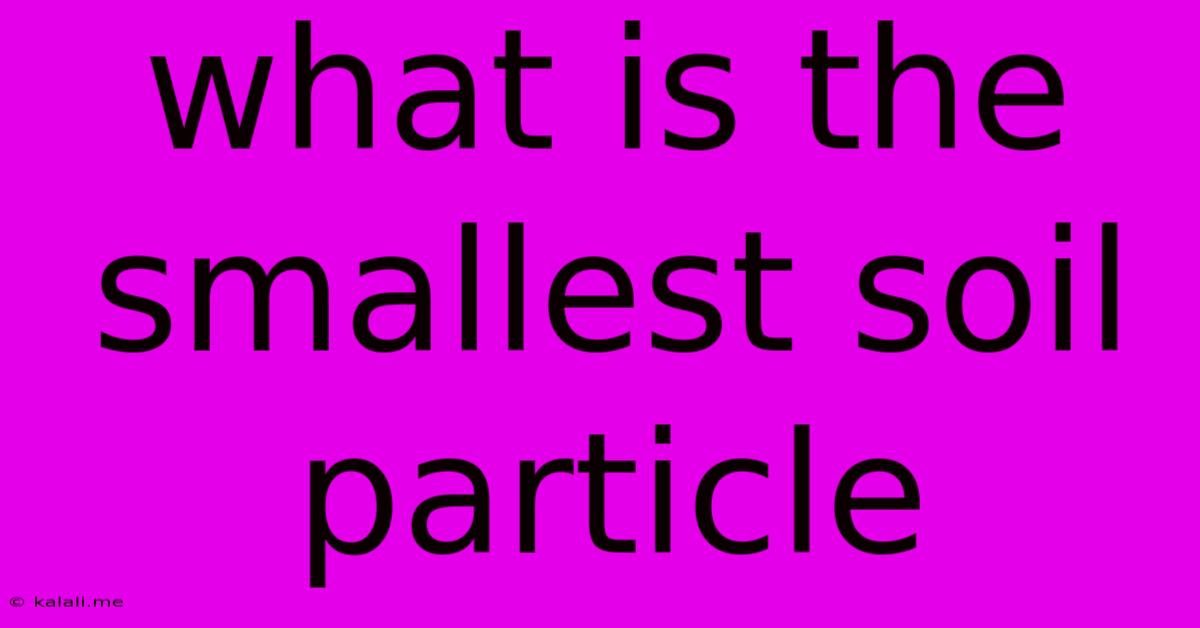What Is The Smallest Soil Particle
Kalali
Jun 14, 2025 · 3 min read

Table of Contents
What is the Smallest Soil Particle? Understanding Soil Texture and Structure
Understanding soil composition is crucial for anyone involved in agriculture, horticulture, or environmental science. A common question that arises is: what is the smallest soil particle? The answer isn't as simple as a single definitive size, but rather involves understanding the different classifications of soil particles and their properties. This article explores the world of soil particles, delving into the smallest components and their role in soil texture and overall soil health.
The smallest soil particles are clay particles. Unlike sand and silt, which are larger and more easily visible to the naked eye, clay particles are incredibly small, measuring less than 0.002 millimeters in diameter. This microscopic size is what gives clay its unique properties and significant impact on soil characteristics.
Clay Particles: Microscopic Marvels
Clay minerals are formed through the weathering of rocks and the breakdown of larger minerals. These minuscule particles possess a unique sheet-like structure, giving them an exceptionally large surface area relative to their volume. This extensive surface area is responsible for several key characteristics of clay soils:
- High Water Holding Capacity: Clay's large surface area allows it to absorb and retain significant amounts of water. This can be beneficial in drier climates but can also lead to waterlogging in poorly drained soils.
- High Cation Exchange Capacity (CEC): The negatively charged surfaces of clay particles attract and hold positively charged ions (cations), such as nutrients. This high CEC is crucial for plant nutrition as it provides a reservoir of essential nutrients for plant uptake.
- High Nutrient Retention: The ability to hold onto positively charged nutrients means that clay soils can retain essential plant nutrients like potassium, calcium, and magnesium, reducing the need for frequent fertilization.
- Plasticity and Stickiness: The tiny clay particles are capable of sticking together when wet, resulting in a sticky and plastic consistency. This is important for soil structure but also presents challenges in terms of workability.
- Compaction: The small particle size and tendency to clump together can lead to compaction, which hinders root penetration and air circulation.
Comparing Soil Particle Sizes: Sand, Silt, and Clay
To fully grasp the concept of the smallest soil particle, it's essential to compare clay with the other major soil components: sand and silt. The following table provides a clear overview:
| Particle Size (mm) | Soil Particle Type | Characteristics |
|---|---|---|
| > 2.0 | Sand | Coarse, gritty texture, excellent drainage, poor water retention, low CEC |
| 0.05 - 2.0 | Silt | Fine, floury texture, moderate drainage, moderate water retention, moderate CEC |
| < 0.002 | Clay | Very fine, smooth texture, poor drainage (when compacted), high water retention, high CEC |
Soil Texture and its Influence
The relative proportions of sand, silt, and clay determine the soil texture. Different soil textures have varying properties influencing drainage, aeration, nutrient retention, and workability. For example, sandy soils drain quickly, while clay soils retain water for extended periods. Understanding soil texture is crucial for selecting appropriate crops and managing soil fertility effectively.
Beyond the Individual Particle: Soil Structure
While clay particles are the smallest, it's also vital to consider soil structure. This refers to the arrangement of soil particles into aggregates or clumps. These aggregates are formed by binding agents like organic matter and microorganisms, impacting soil porosity, aeration, and water infiltration. Healthy soil structure is crucial for root growth and overall soil health, regardless of the size of the individual particles.
In conclusion, while clay particles are the smallest individual soil particles, understanding soil composition requires a broader perspective encompassing the relative proportions of sand, silt, and clay, and the overall soil structure. Each component plays a critical role in determining soil properties, impacting agricultural practices, and environmental sustainability.
Latest Posts
Latest Posts
-
Find Equation Of Plane Through Point And Parallel To Plane
Jun 14, 2025
-
1 Mole Of O2 In Grams
Jun 14, 2025
-
What Are All Factors Of 8
Jun 14, 2025
-
Choose The Correct Html Element For The Largest Heading
Jun 14, 2025
-
Light Wave Is Longitudinal Or Transverse
Jun 14, 2025
Related Post
Thank you for visiting our website which covers about What Is The Smallest Soil Particle . We hope the information provided has been useful to you. Feel free to contact us if you have any questions or need further assistance. See you next time and don't miss to bookmark.